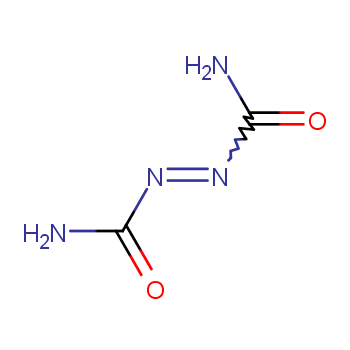 |
[Background and Overview][1][2][3]
Azodicarbonamide is an organic fine chemical product. Its English name is Azodicarbonamide, abbreviated as ADCA or AC. Its chemical structural formula is H2N-CO-N=NCO-NH2< /sub>. AC foaming agent has always been the choice of foam material manufacturers due to its excellent properties such as large gas generation, good dispersion, low price, and the decomposed products are non-toxic, odorless, pollution-free, non-discoloring, and non-corrosive to abrasive tools. Chemical blowing agents are preferred. my country's AC industry started in the early 1960s and is now the largest producer of AC foaming agents. my country began producing AC foaming agents in the early 1960s < By the 1990s, there were more than 30 manufacturers. Our country is already the largest producer of AC < All provinces except Tibet and Hainan have production. Since 1992, various manufacturers have successively carried out expansion and transformation< In recent years, AC production has developed rapidly. From 1996 to 1998, the total production capacity of 21 major domestic manufacturers expanded from 35,000 t/a to more than 60,000 t/a < an increase of 71%< with an average annual increase in production capacity of 8,000 t/a. Larger-scale Jiangxi Electrochemical Plant, Jiangsu Thorpe Chemical Company, Ningxia Electrochemical Plant, etc. have all reached the scale of 10,000 tons. From 1999 to 2000, Jiangsu Suopu Chemical Company, Jiangxi Electrochemical Plant, Fuzhou No. 1 Chemical Plant, Zhejiang Juhua Group Company, Yibin Tianyuan Co., Ltd., etc. also expanded their production capacity. Kunming Electrochemical Plant has a joint venture with South Korea's Jinyang Company to build an 8,000t/a AC device. By the end of 2000, the total production capacity of my country's 19 AC production plants reached 95,000 t/a. Since 2000, <the domestic Azodicarbonamide market has been oversupplied< and has experienced a decline in efficiency. The sales price at the beginning of 2000 was 14,200 yuan/t < by the end of the year it dropped to 11,600 yuan/t. The lowest production cost is 0.92 million yuan/t < Generally, it is 1.06-11.6 million yuan/t < It is a low-profit production.
[Features][1]
Azodicarbonamide is an organic fine chemical product< its scientific name is azodicarboxylic acid amine< It is a light yellow powder< The relative density is 1.65, the decomposition temperature is between 195℃-200℃, and the gas generation volume is 220-250 ml /g; Can be stored for a long time< Not easy to deteriorate< Soluble in alkali, alcohol, gasoline, benzene, pyridine< Hardly soluble in water. Product Azodicarbonamide is a light yellow crystalline powder with a relative density of 1. It belongs to the azo series organic thermal decomposition foaming agent with a high decomposition temperature. The gas production volume is 20 -20 mL/g< Generally in line with the HG-1187-78 quality standard issued by the Ministry of Chemical Industry< That is, the gas production volume of the first-class product is greater than 210m/g < The gas production volume of the second-class product is greater than 200 mL/g < Commercial processing Mainly divided into grades based on different gas generation volume, decomposition temperature, and particle size< Abroad, accelerators are often added to Azodicarbonamide< to obtain modified Azodicarbonamide.
【Foaming Mechanism】[2]
1. Chemical foaming
Azodicarbonamide is a chemical foaming agent. Chemical foaming agents add organic matter that is prone to decomposition to polymer materials, and then extrude the material at a temperature slightly higher than the decomposition temperature of the foaming agent. During this process, The decomposition reaction of the foaming agent produces gas (Azodicarbonamide produces N2), which causes the polymer material to foam. The foaming agent is mixed with the polymer before the material is extruded. A chemical reaction occurs in the extrusion environment above the decomposition temperature to generate by-products relative to the material. These by-products form crystal nuclei in the material and trigger the polymer Generation of bubbles in the melt.
2. Exothermic foaming
Azodicarbonamide is an exothermic blowing agent, so its mechanism can be explained based on the hot spot theory. It is believed that the heat released by the decomposition of Azodicarbonamide causes the polymer melt to be locally heated and becomes a hot spot. At the hot spot, the melt viscosity decreases and the tension decreases, making it easier for the gas to expand and form cells.
3. Primary and secondary reactions
The thermal decomposition reaction of Azodicarbonamide mainly goes through two stages: the main reaction and the secondary reaction. Among them, the main reaction is an exothermic reaction and the secondary reaction is an endothermic reaction. The proportions of primary and secondary reactions will vary with changes in active substances, temperature, etc.
4. Reaction equation
The thermal decomposition mechanism of dry AC foaming agent in air is as follows:

As the decomposition environment changes, the decomposition mechanism of Azodicarbonamide will also change, which is mainly reflected in the changes in decomposition temperature, decomposition enthalpy change and gas generation amount. It can be seen that the decomposition mechanism of Azodicarbonamide is variable, so many experts have a lot of doubts about the decomposition mechanism of Azodicarbonamide.
【Preparation】[3]
1. Acid method: Freeze the synthesized crude hydrazine hydrate solution to -2 ℃<to remove sodium carbonate decahydrate< Add solid urea to the remaining liquid< and add 65% sulfuric acid to neutralize to pH 4~ 5 <Heating should be completed within a few hours< The yield is about 90%. After washing, it is oxidized to generate AC.
2. Weak alkali method: evaporate the crude hydrazine hydrate solution to remove the salt, then add solid urea<and add a small amount of acid< neutralize to pH 7~9 <heat and react to form biurea<no need to wash Direct oxidation generates AC.
3. New method: In the domestic production of Azodicarbonamide, hydrazine hydrate synthesized by the urea method is commonly used as raw material<low yield<high energy consumption<serious pollution<high production cost. Switching to using ketazine as raw material to produce Azodicarbonamide <can increase the yield<reduce energy consumption<lower production costs. The production of Azodicarbonamide from ketazine includes the following steps: synthesis of ketazine; hydrolysis of ketazine with sulfuric acid to obtain hydrazine sulfate; reaction of hydrazine sulfate and urea in aqueous medium to obtain biuret; oxidizing biuret with an oxidizing agent to produce Azodicarbonamide. Hydrolysis of ketazine with sulfuric acid and synthesis of biuret can also be combined into one step. The main industrial methods for developing ketazine synthesis include sodium hypochlorite oxidation and hydrogen peroxide oxidation:
1) Sodium hypochlorite oxidation method: Mix 28% ammonia and industrial acetone <Add 10% sodium hypochlorite< React at 35-40°C with stirring to generate methyl ketone azide. In the case of large excess of ammonia and low concentration of ketazine in the synthesis solution, the synthesis yield can reach more than 98%. In the extraction tower, use methylene chloride to extract the methyl ketone azine in the synthetic solution. The aqueous phase of the raffinate is processed to adjust the composition before being used in the synthesis reaction. The extractant is distilled to recover the extractant methylene chloride< and is reused in the extraction step. Obtain the methylketazine solution from the distillation still.
2) Hydrogen peroxide oxidation method: Add ammonia, hydrogen peroxide and methyl ethyl ketone to the working solution containing the catalyst to react to synthesize ketazine; separate the reaction mixture into a ketazine layer and working solution layer; recover unreacted methyl ethyl ketone from the separated ketazine layer; remove impurities produced by side reactions from unreacted methyl ethyl ketone < and recycle the recovered methyl ethyl ketone Used to prepare ketazine. The hydrogen peroxide used for the reaction can be an aqueous solution with a mass fraction of 30% to 90%; for ammonia, gaseous ammonia and liquid ammonia can be used; for methyl ethyl ketone, commercial products are used in the initial reaction< but recycled ketones< can be used later ; It should be ensured that the molar ratio of sec-butanol and methyl ethyl ketone contained therein is not higher than 0.05 <If it is higher than 0.05 <the yield of synthetic ketazine is reduced. Catalysts can be organic or inorganic amides, ammonium salts, arsenic compounds or nitriles. Amides can be selected from formamide, acetamide, monochloroacetamide and propionamide. Ammonium salts can be formate, acetate, monochloroacetate and propionate. As arsenic compounds, methylarsinic acid, phenylarsinic acid and dimethylarsinic acid can be used. Nitriles can be acetonitrile and propionitrile.
[Application][2][3]
The excellent properties of Azodicarbonamide are widely used in various fields: foaming of coaxial cables, CCP cables, high-density polyethylene, multi-pair metal communication cables and other insulating materials; mainly used in polypropylene, polyethylene, polyvinyl chloride , normal pressure or pressure foaming of chloroprene rubber, butyl rubber, polyamide, natural rubber, ABS rubber, epoxy resin, etc., as well as polyvinyl chloride artificial leather, wallpaper, PE, PVC, PP cross-linked high foaming products, Molding and processing of high-foaming polymer materials for rubber products such as EPDM windshield strips; flour improver and fumigant formulas, which can be used in farm greenhouses, indoors, cesspools, etc.; production agents for airbags, etc.
1) Reduce the density of composite materials. After the bubbles in the foaming system are nucleated, as long as enough gas diffuses into the nucleated cells, the cells will continue to grow, thereby reducing the density of the material.
2) Azodicarbonamide reduces the sensitivity of viscosity to temperature: Because the gas generated by Azodicarbonamide reduces the resistance of continuous motion and reduces the fluid activation energy △Eη, the sensitivity of viscosity to temperature is reduced.
3) As the dosage of Azodicarbonamide increases, the hardness of the material can be reduced and the heat shrinkage will be increased.
4) Azodicarbonamide has the function of a nucleating agent, similar to throwing crushed ice cubes into water. When a small number of bubbles are formed, they will serve as the core to trigger the formation of bubbles of similar sizes.
[References]
[1] Yang Feng, Han Xiangyang. Overview and trends of AC foaming agent technology[J]. China Chlor-Alkali, 2002 (4): 19-21.
[2] Qu Bo, Zhang Liuqin. Foaming mechanism and modification of AC foaming agent[J]. Chemical Industry Management, 2013 (22): 61-62.
[3] You Xiande. Domestic production and application of azodicarbonamide foaming agent[J]. Chemical Propellants and Polymer Materials, 2004, 2(1): 44-48.
 |